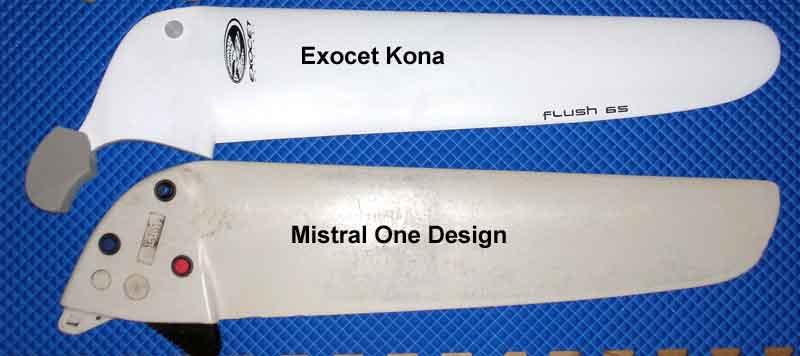|
Dagger Board
A daggerboard is a retractable centreboard used by various sailing craft. While other types of centreboard may pivot to retract, a daggerboard slides in a casing. The shape of the daggerboard converts the forward motion into a windward lift, countering the leeward push of the sail. The theoretical centre of lateral resistance is on the trailing edge of the daggerboard. General A daggerboard is a removable vertical keel that is inserted through a "trunk" in the center of a vessel's hull, usually amidships. Daggerboards are usually found in small sailing craft such as day sailers, which are easily handled by a single person. Daggerboards are not usually ballasted but are locked in place by a clip or pin. Unlike a centreboard, which can be set at different angles to the hull of the boat, daggerboards are generally limited to a single perpendicular position relative to the hull. If a daggerboard is located off center, it is called a leeboard or a bilgeboard. The characteristic whic ... [...More Info...] [...Related Items...] OR: [Wikipedia] [Google] [Baidu] |
Dinghy Sailing
Dinghy sailing is the activity of sailing small boats by using five essential controls: * the sails * the foils (i.e. the daggerboard or centreboard and rudder and sometimes lifting foils as found on the Moth) * the trim (forward/rear angle of the boat in the water) * side-to-side balance of the dinghy by hiking or movement of the crew, particularly in windy weather ("move fast or swim") * the choice of route (in terms of existing and anticipated wind shifts, possible obstacles, other water traffic, currents, tides etc.) When racing, the above skills need to be refined and additional skills and techniques learned, such as the application of the "racing rules of sailing", boat handling skills when starting and when rounding marks, and knowledge of tactics and strategy. Racing tactics include positioning the boat at different angles. To improve speed when racing, sailors should position themselves at the windward direction (closest to the direction of the wind) in order to get " ... [...More Info...] [...Related Items...] OR: [Wikipedia] [Google] [Baidu] |
Vanguard 15
The Vanguard 15 is an American sailing dinghy that was designed by Bob Ames as a one-design racer and first built in 1992.Sherwood, Richard M.: ''A Field Guide to Sailboats of North America, Second Edition'', pages 54-55. Houghton Mifflin Company, 1994. Production The design was built by Team Vanguard in the United States and later by LaserPerformance, but is no longer in production. Design The Vanguard 15 is a recreational sailboat, built predominantly of fiberglass. It has a fractional sloop rig with aluminum spars, a raked stem, a vertical transom, a transom-hung rudder controlled by a tiller and a retractable daggerboard. It displaces and is capable of planing upwind. The boat has a draft of with the daggerboard extended and with it retracted, allowing beaching or ground transportation on a trailer or car roof rack. For sailing the design is equipped with a boom vang and the mainsail and jib have windows for improved visibility. The halyards are external ... [...More Info...] [...Related Items...] OR: [Wikipedia] [Google] [Baidu] |
Laser (dinghy)
The Laser is a class of Single-handed sailing, single-handed, one-design dinghy sailing, sailing dinghies using a common hull design with three interchangeable rigs of different sail areas, appropriate to a given combination of wind strength and crew weight. Bruce Kirby (yachts), Bruce Kirby designed the Laser in 1970 with an emphasis on simplicity and performance. The Laser is a widely produced class of dinghies. As of 2018, there were more than 215,000 boats worldwide. It is an international class with sailors in 120 countries, and an Olympic class since 1996. Its wide acceptance is attributable to its robust construction, simple rig and ease of sailing that offer competitive racing due to tight class association controls which eliminate differences in hull, sails, and equipment. The International Laser Class Association (ILCA) defines the specifications and competition rules for the boat, which is officially referred to as the ILCA Dinghy, due to a trademark dispute. Other ... [...More Info...] [...Related Items...] OR: [Wikipedia] [Google] [Baidu] |
Mirror Dinghy
The Mirror is a type of popular sailing dinghy with more than 70,000 built. The Mirror was named after the ''Daily Mirror'', a UK newspaper with a largely working-class distribution. The Mirror was from the start promoted as an affordable boat, and as a design it has done a great deal to make dinghy sailing accessible to a wide audience. Although most popular in the UK, Mirrors are also sailed in other countries, notably Australia, Ireland, Sweden, Canada, the Netherlands, South Africa, New Zealand, the Philippines and the United States. Design The Mirror was designed by Jack Holt and TV do-it-yourself expert Barry Bucknell in 1962. It employed a novel construction method where sheets of marine plywood are held together with copper stitching and fibreglass tape. This is called tack and tape or stitch and glue construction. Buoyancy is provided by four independent integral chambers rather than by bags. It was originally designed to be built with simple tools and little experie ... [...More Info...] [...Related Items...] OR: [Wikipedia] [Google] [Baidu] |


